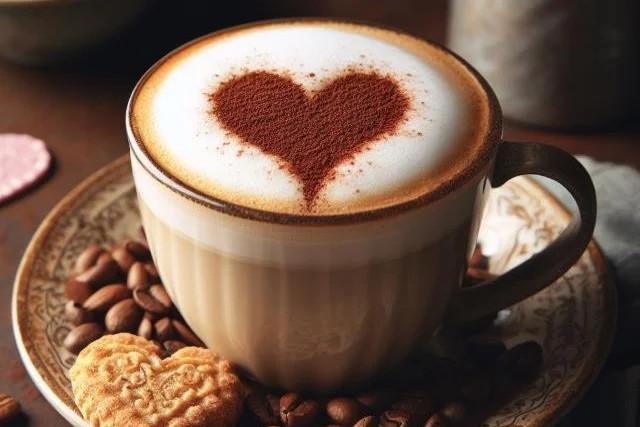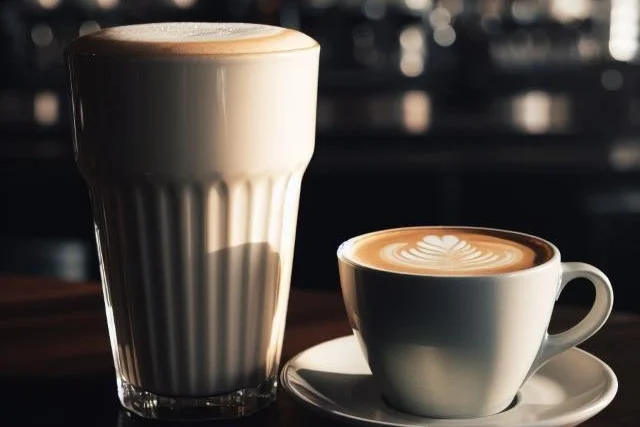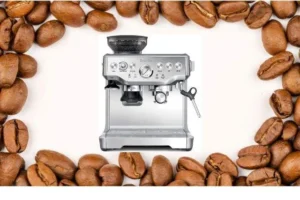Latte vs Cappuccino: Distinguishing Between Two Beloved Espresso Drinks
For coffee aficionados, debates rage eternally over latte vs cappuccino – which espresso beverage truly reigns supreme? With their similar appearances but contrasting textures and flavors, it’s easy to confuse these two café classics. This comprehensive guide will compare every aspect of the latte vs cappuccino showdown so you can become an espresso expert.
Key Takeaways
- Ingredient Differences: Lattes feature more steamed milk and less foam, resulting in a creamier, sweeter taste, while cappuccinos are characterized by equal parts espresso, steamed milk, and frothy foam, offering a stronger, bolder flavor.
- Preparation Distinction: Crafting a latte involves layering steamed milk over espresso, while cappuccino preparation showcases the art of combining espresso and thick, frothy foam.
- Customization Opportunities: Lattes provide a canvas for numerous flavor variations and milk options, whereas cappuccinos traditionally focus on maintaining the essence of espresso and foam.
- Serving Size and Pairing: Lattes are typically larger and go well with sweet treats, while cappuccinos are served in smaller cups, pairing excellently with savory dishes.

Key Differences Between Latte vs Cappuccino at a Glance
Before diving deeper into the nuances, here is a quick reference table outlining the main contrasts between latte and cappuccino:
| Factor | Latte | Cappuccino |
| Espresso shots | 1 | 1 |
| Steamed milk | More | Less |
| Foam | Little or none | Thick, frothy layer |
| Strength | Medium | Strong |
| Sweetness | Sweeter taste | Less sweet |
| Customizability | More options | Fewer variations |
| Cup size | Larger | Standard 6-8 oz cup |
Now let’s explore the origins, ingredients, prep methods, and more that set these drinks apart.
The Backstory: History Behind Latte vs Cappuccino
To understand the current latte vs cappuccino craze, it helps to revisit how each drink developed over time.
The Latte’s Journey
While the latte seems trendy, its roots trace to 18th century Italy as “caffe latte” – coffee and milk. More widespread use came through Italian coffee bars in the mid-1900s thanks to espresso machines.
In the late 1900s, the latte gained international prominence with the rise of coffee chains like Starbucks. The latte remains an Italian classic but creative baristas worldwide now put their own spin on recipes and variations.
The Cappuccino’s Past

Like the latte, the cappuccino also emerged in Italy but in the early 20th century. The Catholic Capuchin monks helped popularize the drink, valuing its rich flavor and energizing effects during long prayer services.
The cappuccino then spread from monasteries to coffee bars and restaurants throughout Italy in the early 1900s. The traditional Italian cappuccino contains equal parts espresso, steamed milk, and foamed milk.
So while both drinks originated in Italy, the latte vs cappuccino timeline shows the latte is a newer reinvention while the cappuccino upheld tradition longer.
Perfect Ingredient Ratios: What’s in a Latte vs Cappuccino
One major point of distinction in the latte vs cappuccino battle lies in the specific ingredient ratios used.
Latte Ingredients
- 1 shot of espresso
- Steamed milk
- Little to no foam
Lattes consist mainly of silky steamed milk with a shot of espresso added. The abundance of hot, velvety steamed milk gives lattes a naturally sweeter, creamier taste.

Cappuccino Ingredients
- 1 shot of espresso
- 1/3 steamed milk
- 1/3 foamed milk
Cappuccinos contain equal amounts of espresso, steamed milk, and thick foamed milk. The generous layer of airy, dry foam gives cappuccinos a bolder taste compared to the sweeter latte vs cappuccino matchup.
Preparation Showdown: Crafting Each Drink
A skilled barista not only respects proper ingredient ratios but also masters the hands-on preparation process.
Making a Latte
- Brew a shot of espresso and pour into the cup.
- Steam fresh cold milk until piping hot and velvety smooth.
- Slowly pour the steamed milk over the espresso.
- Top with a thin layer of foam if desired.
The Art of Crafting a Cappuccino
- Brew a shot of espresso and pour into the cup.
- Steam some cold milk, then continue heating to form thick, frothy foam.
- Pour the steamed milk and spoon the foam together into the cup.
- Top with additional foam and do the final decorative etching.
The latte showcases the art of creating beautifully silky steamed milk, while the cappuccino highlights the skill of free-pouring flawless foam.
Flavor and Strength Profile Differences
With their unique recipes and preparation methods, lattes and cappuccinos offer contrasting flavor experiences:
Latte Taste Profile
- Creamy, sweet flavor from the milk
- Espresso plays a supporting role
- Lower caffeine content
Cappuccino Taste Profile
- Strong espresso flavor cutting through the milk
- Foam adds sweetness
- Bolder caffeine kick
Do you prefer your coffee drinks to be milder and sweeter or bold and complex? That personal preference will point you towards either a latte or cappuccino when deciding between the two.
Customization Potential: Unique Options for Latte vs Cappuccino
Beyond just the traditional recipes, some creative customization options can transform a latte or cappuccino into your own unique creation:
Fun Latte Customizations
- Flavored syrups – vanilla, caramel, pumpkin spice, etc.
- Alternative milks – soy, oat, almond, coconut
- Number of espresso shots
- Sweetness level
- Temperature tweaks
- Fun toppings – cinnamon, cocoa powder, etc.
Cappuccino Customizations
- Alternative milk options
- Number of espresso shots
- Dry vs wet (more or less foam)
- Subtle flavored syrups
- Creative toppings like chocolate shavings or nutmeg
The latte’s focus on milk lends itself to nearly endless flavor combinations. But cappuccinos traditionally aim to showcase the purity of espresso and foam.

Serving Size Comparison: Small vs Large Cup Styles
Along with distinct flavor profiles, lattes and cappuccinos differ in their traditional serving sizes and cup styles. However, some progressive coffee shops buck these classic norms.
Traditional Latte Servings
- Typically served in larger cups from 12-20 oz
- Allows for additional steamed milk
Classic Cappuccino Servings
- Traditionally served in smaller 6-8 oz cups
- A thick layer of foam limits drink volume
Some cafes now offer “long” or “large” cappuccinos in bigger cups. At a new spot, ask if drink size affects the proportions or preparation method. Do you want just a few sips or a longer savoring experience?
Pairing Drinks with Food: Complementary Flavors
The signature flavor profiles of lattes and cappuccinos make certain food pairings shine:

Sweet Latte Pairings
- Baked goods like muffins, scones
- Pancakes, waffles, and French toast
- Oatmeal or granola with fruit
- Desserts like tiramisu and crème brûlée
Bold Cappuccino Pairings
- Croissants, biscotti, or brioche
- Hearty breakfast sandwiches
- Savory dishes like pizza, pasta, or flatbreads
Consider if you want your beverage to complement or contrast with your food’s flavor.
Regional Versions: Latte vs Cappuccino Around the World
As Italian immigrants spread worldwide, other cultures put unique spins on lattes and cappuccinos:
Global Latte Variations
- Spain: Café con leche with more steamed milk
- Poland: Kawa latte with whipped cream topping
- Mexico: Cinnamon and brown sugar blended in
International Cappuccino Mutations
- Austria: Dense whipped cream topping
- Australia: Flat white with latte-style microfoam
- Middle East: Mix with Greek or Arabic coffee and foam
When traveling, some cafes offer both traditional and local versions of these espresso drinks. Ask your barista for recommendations on specialty regional preparations.
Beyond Latte vs Cappuccino: More Espresso Drinks to Explore
Once you become a latte vs cappuccino expert, it’s time to expand your skills and tastebuds with these other coffeehouse favorites:

- Cortado: Espresso “cut” with warm steamed milk. A creamy middle ground between the cappuccino and latte.
- Americano: Espresso shots diluted with hot water. Captures the strength of drip coffee.
- Mocha: Chocolate-flavored latte. The perfect sweet and decadent treat.
- Red Eye: Basic coffee with an extra shot of espresso. For those who need a caffeine boost.
- Breve: Latte made with half-and-half instead of milk. A richer, creamier variation.
The Final Sip: Finding Your Cafe Drink of Choice
With the distinctions between latte vs cappuccino now clear, you can confidently order your next café drink like a true coffee connoisseur. Savor each layer of espresso, steamed milk, and foam. Let your unique taste preferences for sweetness, strength, and size guide you toward your perfect beverage.
The key is to enjoy the journey into coffeehouse culture and espresso expertise. So go forth, cozy up at your favorite cafe, and treat yourself to a handcrafted latte or cappuccino crafted just for you. The last sip choice is yours!
FAQs
A: The main difference is that lattes contain more steamed milk and less foam, resulting in a creamier, sweeter flavor, while cappuccinos have equal amounts of espresso, steamed milk, and thick frothy foam for a bolder taste.
A: Both lattes and cappuccinos contain a single shot of espresso. The amount of espresso is the same, while the milk and foam proportions vary between the drinks.
A: Most traditional versions use dairy milk such as whole milk or 2% milk. But non-dairy milks like soy, almond or oat work well too. The milk choice depends on your taste preferences and dietary needs.
A: Yes, lattes in particular lend themselves to custom flavors with syrups, milk alternatives, toppings, etc. Cappuccinos tend to stay more traditional, but can also be tweaked slightly with ingredients like flavored syrups.
A: Since they both contain a single shot of espresso, the caffeine content is essentially the same. The extra steamed milk and foam don’t significantly alter the caffeine levels. So in terms of a caffeine boost, lattes and cappuccinos are equal.








